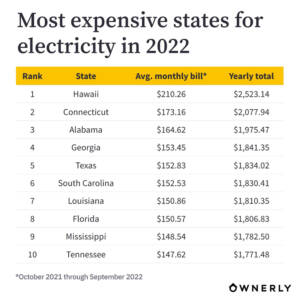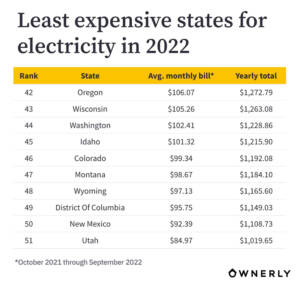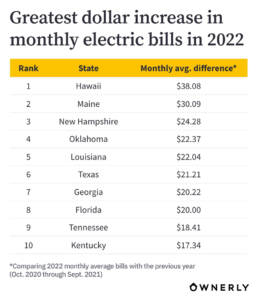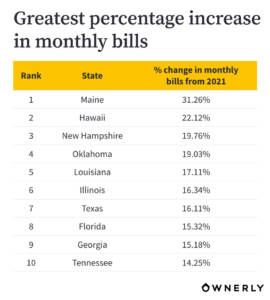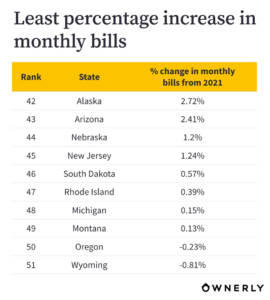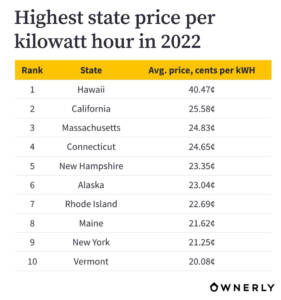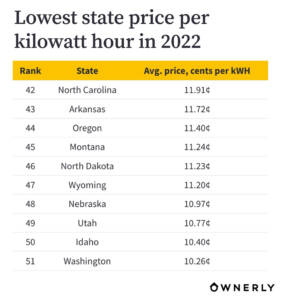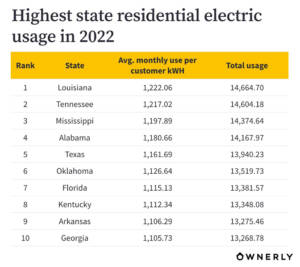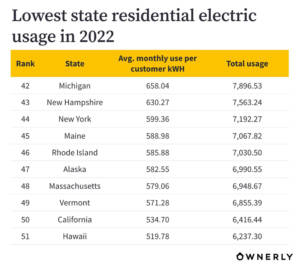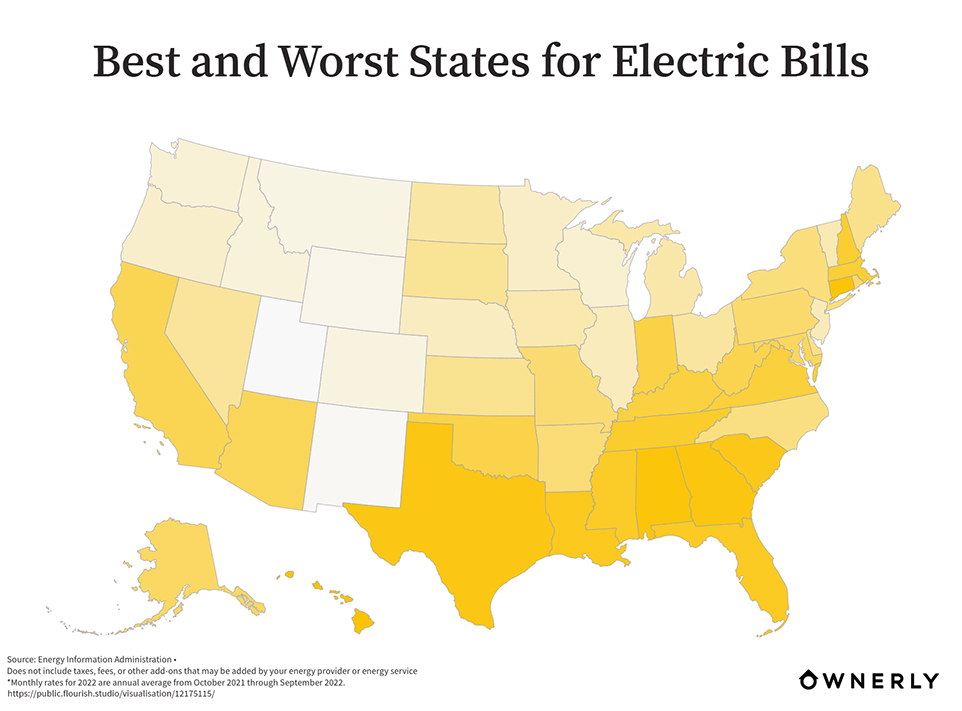
A newly released study from Ownerly, a leading home and property value estimation platform, analyzed 12 months of Energy Information Administration (EIA) data and found the increase in out-of-pocket consumer spending exceeded 22 billion—not all related to an increase in usage.
Ownerly examined electricity price data between October 2021 and September 2022 to identify which states paid the most in 2022, which states saw the greatest percentage increase from the previous year and where overall electric costs increased the most. The time period of their analysis also coincides with the highest inflation rates Americans have seen in four decades.
Key takeaways
- Hawaii and Connecticut had the highest monthly electric bills in 2022; Utah and New Mexico had the lowest. Hawaiians paid on average $210.26 a month, followed by Connecticut ($173.16), Alabama ($164.62), Georgia ($153.45) and Texas ($152.83).
- Hawaii had the greatest dollar increase in energy costs, but Maine had the highest bill increase. While monthly bills went up $38.08 in Hawaii, Maine saw the highest bill increase over the 12 months we examined, paying 31.26% more monthly than the previous year.
- Prices in Wyoming and Oregon actually dropped in 2022. Not all states saw a monthly rise in electric bills: monthly average bills dropped slightly in Wyoming (-79¢) and Oregon (-24¢).
These bills also include higher electricity usage during the summer months. “So many of the colder states that use more energy in the winter than the summer, like North Dakota, Tennessee and West Virginia, could see those same increases this winter,” McCusker said.
The EIA also expects US energy prices to remain high into 2023.
Georgia Rankings:
- Most Expensive States for Electricity in 2022 – #4, with the average monthly bill being $153.45, and yearly total $1,841.35
- Greatest Dollar Increase in Monthly Electric Bills in 2022 – #7, with a monthly average difference of $20.22
- Greatest Percentage Increase in Monthly Bills – #9, with a 15.18% change in monthly bills from 2021
- Highest or Lowest in State Price Per Kilowatt Hour in 2022 – Georgia did not rank in the top 10
- Highest State Residential Electric Usage in 2022 – #10, with $1,105.73 for avg monthly use per customer kWH, and $13,268.78 for total usage
Ownerly’s tips on how to lower your electric bills
The following energy-saving tips can help lower electric bills without necessarily requiring costly retrofits or remodeling.
- Be mindful of maintenance. Keep appliances running efficiently by periodically vacuuming under your refrigerator and changing your HVAC filter, among other things. Home appliances consume less electricity when they are properly maintained.
- Look at your lighting. Invest in energy-efficient LED bulbs and use translucent lampshades to maximize their performance. Motion sensors can be connected to your lamps to turn them off when not in use. This can also be accomplished with smart bulb schedules and automation.
- Ask your provider for an energy audit. Many utility companies offer free consultations for ways to help lower your energy bills. Also, many states offer incentives for energy efficiency. Check the Database of State Incentives for Renewables & Efficiency and plug in your zip code to find programs in your area.
- Check for available rebates. Some cities or energy providers may offer rebates to homeowners who use smart thermostats, energy-efficient appliances, smart lighting or other energy-saving technologies. Reach out to your bill provider and ask if there are any rebates or incentives available to you.
Costlier home modifications can generate bigger energy savings, but may not pay for themselves in the near term. If you happen to be remodeling anyway, some energy-conserving upgrades to consider include:
- Adding more insulation to retain indoor heating and cooling
- Swapping in energy-saving appliances
- Installing energy-efficient doors and windows
- Improving your HVAC system
Find more tips here on How to Save Energy at Home
Methodology
To determine monthly electric bills by state, Ownerly examined residential estimated electricity use and sales data from the US Energy Information Administration from October 2018 through September 2022. For the purposes of this study, 2022 refers to energy prices and usage from October 2021 through September 2022. Note that statistics do not include any customer service charges from providers.
About Ownerly
Ownerly provides homeowners, buyers and sellers with professional-grade home values used by real estate agents, banks and lenders. With Ownerly, users get important home sales insights and can track the value of their single most important investment—their home.
Source: Ownerly


Chattooga Local News
Carr Convicts 16 in Barrow County, Shuts Down Prison Gang Operation

Bulloch Public Safety
12/04/2025 Booking Report for Bulloch County

Bulloch Public Safety
12/02/2025 Booking Report for Bulloch County

Bulloch Public Safety
11/10/2025 Booking Report for Bulloch County

Bulloch Public Safety
11/24/2025 Booking Report for Bulloch County

Bulloch Public Safety
11/06/2025 Booking Report for Bulloch County

Bulloch Public Safety
12/01/2025 Booking Report for Bulloch County

Bulloch Public Safety
11/12/2025 Booking Report for Bulloch County



